
New Line Item: COVID-19
How construction costs have been impacted by COVID-19
Written by Kenneth F. Wille, PE from KOW Building Consultants
JUne 26, 2020
If you went back in time to your 2019 self and showed pictures of shuttered restaurants, masked supermarket shoppers, and make-shift hospitals set up in parking lots, you’d have a hard time convincing yourself that this would be in America less than a year later. To think of the immediate impact that COVID-19 has had on our lives is quite astonishing. In so much as it has impacted all aspects of the construction industry, here are five cost impacts that COVID-19 has had on the construction industry in the US (so far!):
Cleaning and Sterilizing
Many projects now have professional cleaning crews or even in-house crews that clean daily. This expense hits twice as it represents time and monetary expense not originally budgeted for at the beginning of the project. For those construction sites closing slightly early to perform this daily work, it means longer trade schedules, and potentially a later completion date.
Personal Protective Equipment (PPE)
The construction industry has long required PPE for worker safety. But where this once included proper footwear, eye protection, reflective vests and hard hats, it now includes masks and sometimes gloves. Visitors to the site can cause a disruption by needing social distancing buffers as well. Also included here are the unintended expenses for hand wash stations (requiring running water), anti-bacterial stations and additional toilet rooms.
Local Product Upcharge
The immediate impact was limited to procuring materials from China, which supplies a tremendous amount of cabinetry, electronics, and seemingly everything to the construction industry. Things seemed to have normalized recently but keep an eye on supply chains and trade talks with China and other countries. Remember you may have production in, say Canada, but raw materials might be from China which could cause a delay.
Additional Labor
Many GCs and CMs have had to employ additional laborers to help subcontractors with cleaning their respective areas. Other additional labor is being used for safety check-ins and reporting for building departments. For GCs or CMs that are employing personnel to sign people in, check temperatures and assure that PPE is being worn, this is another unexpected cost to bear.
Schedule and General Condition Change Orders
Projects that were shut down temporarily incurred delays and change orders due to COVID-19. During the first weeks and even months of COVID-19 workforce levels fell, sometimes as much as 50% or more. What was most striking was that this was largely not due to subcontractor boycotting sites but the workers not showing up. Whether fears of contracting the virus, worries about a loved one or a family member in a high-risk category or unemployment offering little incentive to take the risk of working, we noticed workers voted with their feet and stayed home. This has largely passed, and most projects have seen a return to normal levels but be prepared for an onslaught of Force Majeure change orders. Overall, we have seen as many as 6 months or more added to project schedules.
Conclusion
No one has a crystal ball but keep an eye on change orders and cost increases. The impact has not been terrible yet, but we are far from out of the woods with COVID-19. Stay safe…and wash your hands!
Kenneth F. Wille, PE is President and CEO of KOW Building Consultants. KOW provides building and construction consultation services to traditional banks, private lenders, mortgage lending institutions, state housing agencies, city housing agencies, mezzanine lenders, other financial institutions, as well as owners and developers. The firm was founded in 1978 by Kenneth O. Wille, P.E., who provided construction loan monitoring and property condition assessment services for New York City projects. The company has grown to employ technical plan reviewers and construction monitors from various backgrounds including civil engineering, electrical engineering, architecture, building code inspectors, construction management and construction lending.











